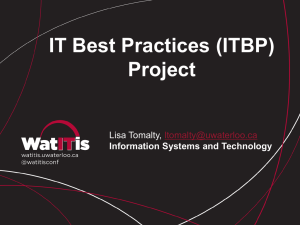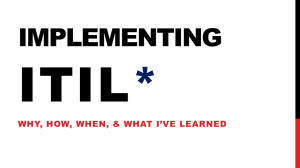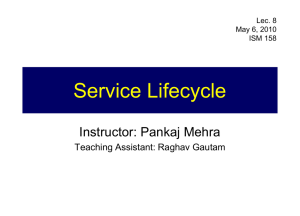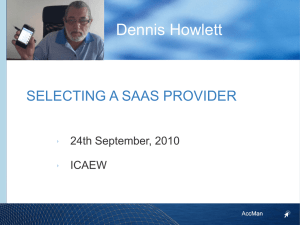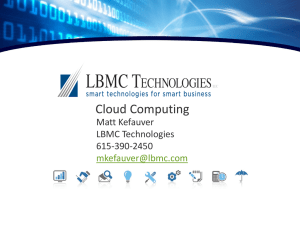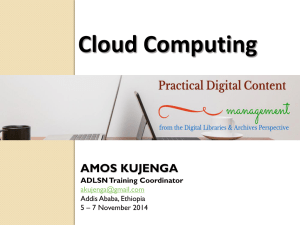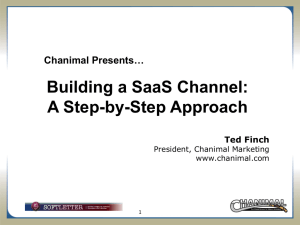ITIL and the Cloud
advertisement
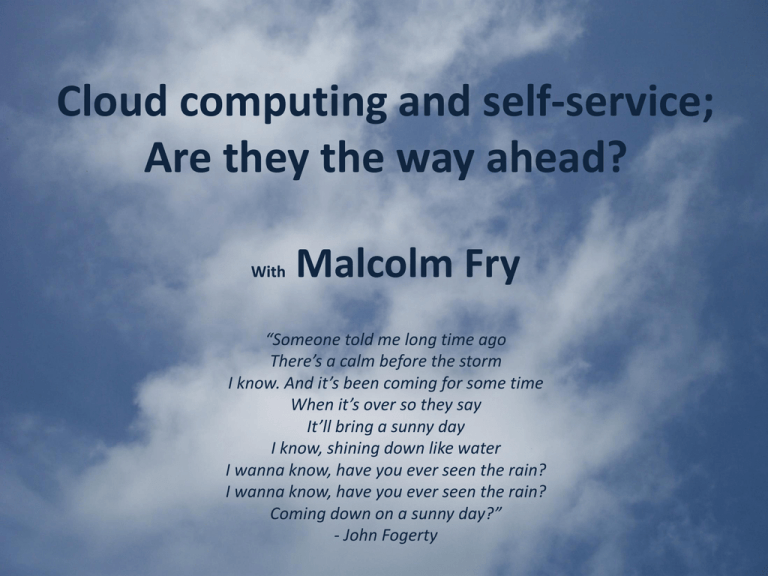
Cloud computing and self-service; Are they the way ahead? With Malcolm Fry “Someone told me long time ago There’s a calm before the storm I know. And it’s been coming for some time When it’s over so they say It’ll bring a sunny day I know, shining down like water I wanna know, have you ever seen the rain? I wanna know, have you ever seen the rain? Coming down on a sunny day?” - John Fogerty Technology is changing everyday life I love being able to make my own choices in my own time Life is now about……. • • • • • • • Making your own decisions Deregulation Making your own choices Small world big options No waiting Portable technology Straight to the product The world in our pocket • • • • • • • • Buy and sell Exchange information Limitless knowledge Instant news Virtual everything No international barriers New communities Business has changed Child’s eye view Technology • • • • • • • Icons that no longer exist – Diskette Plasma/LED televisions Camera telephones capture everything Electronic home work submission Techno tool taught at school e.g. PowerPoint Maps? When you have Google earth? Just an extension of the Kindergarten Not just children • Direct to the Customer (DttC) services make life easy • IT engages in a huge amount of work and deploys significant resources to make things seem so easy • It is not just children - according to IMRG in December 2010 of £6.8 billion, equivalent to an average spend of £111 (approximately US$170) for every person in the UK. SaaS needs Common rule sets The cloud and SaaS services ITIL evolution De facto ITSM standard ITSM already supports SaaS ETOM has ITIL compatibility Hybrid’s Cloud & SaaS • • • • • • Speaking a Common Language http://csrc.nist.gov/publications/drafts/800-145/Draft-SP-800-145_cloud-definition.pdf 8 NIST Cloud definition • “Cloud computing is a model for enabling ubiquitous, convenient, on-demand network access to a shared pool of configurable computing resources (e.g., networks, servers, storage, applications, and services) that can be rapidly provisioned and released with minimal management effort or service provider interaction. • This cloud model promotes availability and is composed of; five essential characteristics, three service models, and four deployment models.” Deployment Service models? Models? private cloud SaaS community cloud PaaS public cloud IaaS hybrid cloud 10 Controls Networks Servers Operating Systems Storage Deployed Applications Software as a Service SaaS Platform as a Service PaaS Infrastructure as a Service IaaS control limited control no control 11 Supporting and Servicing SaaS is a double edged sword ITIL v3 a logical approach • ITIL v2 concentrated on Service Support and Service Delivery • ITIL v3 has a life cycle approach • There is an emphasis shift from retro fitting • To get it right first time • Selecting a SaaS tool is a science Role changing • Two party approach to IT Service Management and cloud? • Mind set and platform changes • The invisible and inaccessible? • It is very difficult to leave SaaS? The five key ITIL phases ITIL Service - strategy ITIL Service - design ITIL Service - transition 1 2 3 4 ITIL Service - operation ITIL Service - CSI Should ITSM use SaaS products? • Yes because these are the NIST essential characteristics work better if ITIL is employed: • • • • • on-demand self-service broad network access resource pooling rapid elasticity measured service • It also easier to support a service that you understand • Ideal if both SaaS supplier and ITSM are ITIL compliant SaaS and ITIL • SaaS maybe a current trend but old processes never die • Or will SaaS eliminate • • • • • Changes Incidents Availability Capacity etc? Cloud and Deregulation • Cloud computing is the beginning of the deregulation of IT – maybe this should be at the beginning or even the theme IT Deregulation is the removal or simplification of government rules and regulations that constrain the operation of market forces. Deregulation does not mean elimination of laws or property rights but eliminating or reducing of ITagainst securityfraud or asset ownership government control of how business is done, thereby moving toward a more IT laissez-faire, free market. for IT services. It is different from liberalization, where more players enter in the market, but continues the regulation and guarantee of consumer and of servicerights levelsand andmaximum fit for purpose IT minimum prices. 8 Key Questions 1. Why should organizations that are moving to SaaS care about ITIL? Exclusively Then ITILofcompliance isand now Common All Why would theSaaS? components ground youNo? not you need to integrate old dewill facto standard common of make ITIL your will terminology still SaaS exist- abut and new perfect yardstick with the offering roles SaaS ITIL will suppliers compliant? change 2. Is it important for the SaaS supplier to be ITIL certified? Or is it more important that the IT organization be ITIL certified? Certification Certification Importance Award Both should be certified Subject Supplier PinkVerified or similar Is it important for the SaaS supplier to be ITIL certified? Same rules = same game Or is it more important that the IT organization be ITIL certified? IT will benefit from compliance 3. How do you respond to comments that “ITIL just gets in the way of the agility of a SaaS platform”? Agility Agilitymust without be channelled discipline isto avoiddangerous circumventions 4. How do you address comments that “ITIL is old school. SaaS is modern. How can the two converge? “ • ITIL is being refreshed as we speak • Which of the ITIL disciplines are no longer relevant? • SaaS is simply a means to an end • By looking at each ITIL process and asking who performs which role? • By ensuing that the customer is involved by the SaaS supplier 5. What should IT organizations look for in regards to ITIL with a SaaS supplier? I MSD PMCMC ONFIGAS SETMAVAILM CAPMSLAPORTFOLIOM I W I L L B U Y M A L C O L M A B E E R 6. What are the biggest challenges IT organizations face with ITIL and SaaS? 7. How can IT organizations best address these challenges? It’s a Team Game Jointly identify the key common Produce/alter processes as Get a contact point for ITIL Establish regular communications ITSM can be Customer and from User Appoint an ITIL/SaaS co-ordinator ITILappropriate components the SaaS supplier 8. What are some key observations? A new dichotomy • Some companies are now competing internally for the same customers • For example, it was reported that sales from the on-line Next Directory retail catalogue and Internet arm rose 15.3% • While like-for-like store sales fell by 7.5% • Here, we have two sales-driven divisions vying for the same customers • Where would you invest? The progression of IT Services Personal computers Dumb terminals Remote Job entry Batch Data Prep Data Control Agreed schedules Tech support SLAs Change Management Best Practices ITIL / Cobit Quantum Change No longer just a cost centre now contributing to the bottom line In some cases FEFO is the bottom line GoToAssist Yahoo Google Amazon Fully FEFO enabled Facebook eBay The new ROI function • Now, it is not just Return On Investment but also Return On Insurance • The aim is investing to avoid any potential service interruption to the customer, rather than saving revenue by reducing Service Management costs • The question is not what does ITSM cost but what happens if we don’t investment in ITSM • It is not until a major DttC application failure occurs that the full extent of the damage can be assessed • The key is to identify DttC applications and make them as resistant and resilient as possible as possible to avoid unplanned downtime • IT needs to both closely monitor key DttC services and protect against potential unplanned outages. I am the genie of the Cloud give me 100% availability, fast performance and all this 7/24 I am the genie of the Cloud give me 100% availability, fast performance traditionaland approaches to all this 7/24 Changing the IT mindset • It is obvious that supporting IT services have to change • IT can no longer work to targets that tolerate failure or complacency • IT must adopting a 100% target for high FEFO ratings • Whenever 100% is not hit IT should launch an investigation to find out why and stop this defect from occurring again or at least minimizing the risk. Best Practices eTOM Six Sigma ISO ITIL COBIT Blurring of Responsibilities • There were clear lines of demarcation • But what happens when FEFO kicks in and DttC services start to proliferate? • Who does the external customer contact IT or a corporate customer service point? • Who owns local support? • The key point here is to identify those areas where FEFO services are providing DttC support, identify the blur points, work with the business units to establish where responsibilities lies and then adopt those responsibilities. Risk Management • Is this the Achilles heel of ITSM? • How much time is spent on Risk Analysis and the implications of failure? • What happens if the Front End fails? • What are the potential costs of failure? • Return on Insurance!!! Morphing • • • • • • • Morphing from – to: From to Action to Strategy and Design IT Back Office to IT Front Office Performance reporting to Strategic reporting From Fixers to Avoidance Managers From never consulted to always consulted From watching new services to becoming key players in new services Adopt an SSSM stance • What can you transfer to your corporate customers? • Is SSSM part of your ongoing plans? • Are you investing in the correct technology • Perhaps you should look at Cloud technologies • Adopt and Adapt is the key to success Service Transition Change Management Service Asset & Configuration Management Release & Deployment Management Transition Planning & Support Service Validation & Testing Evaluation Knowledge Management Service Operation Service Desk Incident Management Problem Management Request Fulfilment Access Management Operational Activities in other Lifecycle Phases Event Management Technical Management IT Operations Management Applications Management Summary - 1 • There is little doubt that the future will be driven by DttC • Too often, IT has been good but not good enough IT must step up to the big challenge that lies ahead • It is now an exciting time for IT Service Management (ITSM) to emerge from the • The business differentiators gained from implementing FEFO can only be successfully realized if ITSM steps up to the challenge. This is just one strategy to enable organizations to master the new wave of mobile support. Summary - 2 • The vast majority of the DttC services discussed here will be provided through mobile support devices • But to gauge the impact of poor ITSM what would happen if the technology failed? Close the facility? • Who knows but one thing is certain ignoring the importance of FEFO will dramatically increase the possibility of that failure. The End malcolm@malcolmfry.com www.TheITILLiteBook.com www.TheITILLiteWorkshop.com Thank you to BMC for their sponsorship and CITRIX for the use of some webinar slides
